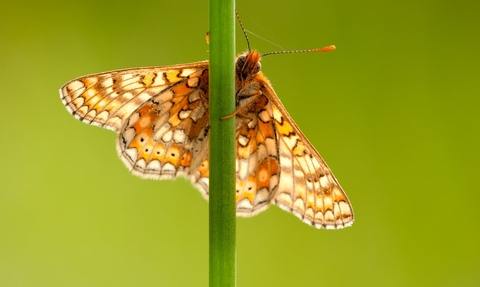
Ross Hoddinott/2020VISION
Bringing back our missing species
We have seen otter, water vole and the rare marsh fritillary butterfly brought back from the brink
But what's next for our missing species?
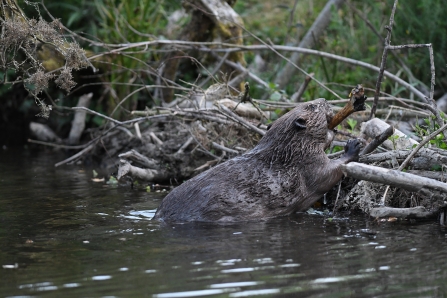
© David Parkyn/ Cornwall Wildlife Trust
Public concern for the environment is at an all-time high and people are calling for more nature in their lives.
We have plans to make this happen in our two counties and returning our missing species to the countryside is an integral part of our vision for a Wilder Hampshire and Isle of Wight.
We are in a climate emergency and biodiversity crisis. Decisions and actions taken in the next ten years will affect the next thousand years.
By 2030 we must see nature recovering and wildlife returning - if we delay, the damage will be irreversible.2020-2030 Wilder Strategy
What are missing species?
Missing species are animals and plants that were once present in our natural environment, but which have been driven to local (or, indeed, national) extinction.
Every species has a role to play in the complex jigsaw of our natural world, and if we don't reverse this trend of decline, our ecosystem will eventually collapse.
Our Missing Species Programme
We have a strong track record of working to bring back missing species, and have seen otter, water vole and marsh fritillary return to their former haunts. We have also seen other species, such as the white clawed crayfish and sword-leave helleborine, bounce back from the brink of local extinction.
What is the Missing Species Programme?
- Working with others, we want to see the return of species in our two counties, which may then act as a catalyst for the recovery of entire ecosystems and wildlife communities.
- We want to harness the public's enthusiasm, and contribute to a new norm for today’s generation of children, giving them a positive baseline for the natural environment around them.
- We will take an evidence based approach, working in partnership with others, to understand and address the reason for the loss of species.
- We are learning from experience and successes across comparable urban and rural landscapes in Europe and the UK. This gives us confidence that our busy modern counties could make much more space for nature.
What are we aiming to achieve?
The Missing Species Programme must address the biodiversity crisis and help create a nature recovery network within the two counties.
Creating a climate resilient landscape
The climate emergency poses a threat to people and wildlife, and this programme must seek to support a more climate-resilient landscape where wildlife can thrive and adapt to the future.
Some species, also known as ecosystem engineers, will be central to this approach and help to drive the recovery of entire ecosystems while also providing multiple benefits to people, such as natural flood protection and improvements to water quality.
Health and wellbeing
Nature has intrinsic value and is a big part of people’s health and wellbeing. Our programme will seek to maximise our connection with the natural world.
Nature based economy
Supporting the growth of a thriving nature-based economy will be part of the programme.
As much as we depend on nature for clean air, water and soils, there is also a value to livelihoods. People visit areas to see wildlife and Hampshire’s diverse landscape, its existing richness of wildlife, and the burgeoning potential to enhance this, could make our two counties one of the foremost destinations to see wildlife once again.
What are the next steps?
We will be bringing together local experts and stakeholders before any reintroduction proposal is taken forward. A thorough assessment will be carried out and the following elements will be conducted:
- Following international reintroduction guidelines a feasibility study will be carried out. This will seek to answer key questions such as whether the habitat/landscape is suitable? Have the factors that drove the species to local extinction been rectified and can the appropriate habitat management be put in place?
- An assessment of the potential effects of the proposed reintroduction on biodiversity and socio-economic interests.
- A contingency plan to cover negative effects and an exit strategy.
- Public consultation with local communities and landowners.
Our ambitions
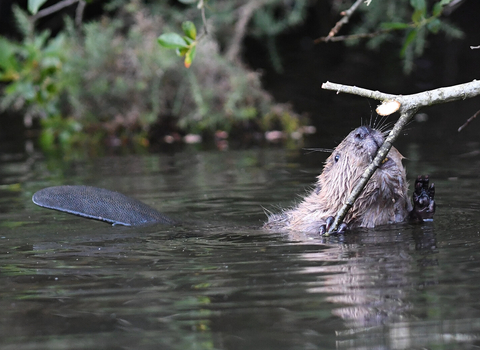
David Parkyn - David Parkyn/ Cornwall Wildlife Trust
Beavers
Beavers are native to the UK and once played an important part in our landscape.
Beavers are often referred to as ‘ecosystem engineers’. The loss of this charismatic species has led to loss of the mosaic of lakes, meres, mires, tarns and boggy places that they built so brilliantly.
They make changes to their habitats, such as digging canal systems, damming water courses, and coppicing tree and shrub species, which create diverse wetlands. In turn, these wetlands can bring enormous benefits to other species, such as otters, water shrews, water voles, birds, invertebrates (especially dragonflies) and breeding fish.
What we have already been doing
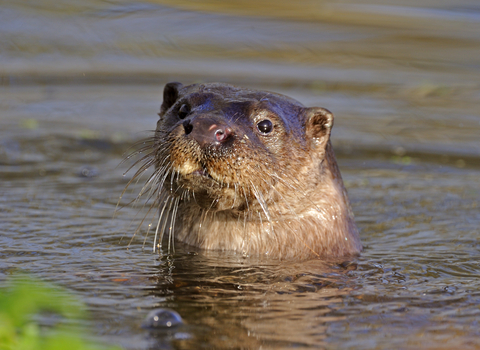
Otters
Pushed to the brink by hunting, habitat destruction and pesticides, otters almost disappeared from rivers and waterways in England and were virtually extinct in the south east by the end of the 1970s. But after huge efforts to improve conditions for otters in our local wetlands, these elusive animals have recolonised most river catchments in Hampshire, with records of successful breeding.
By working closely with landowners and river managers, offering advice and delivering river restoration work, we were able to create space for otters on a landscape scale.
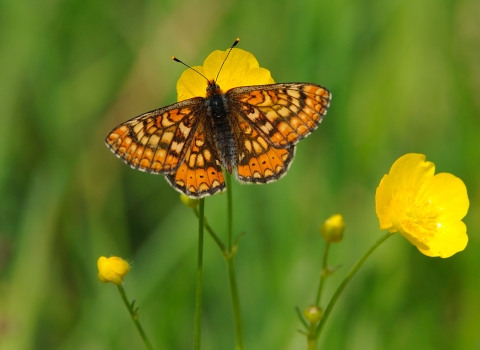
© Amy Lewis
Marsh Fritillary
The marsh fritillary was once widespread across Britain. However the species suffered from years of habitat loss and degradation and the last marsh fritillary butterfly disappeared from north Hampshire's meadows in 1996.
In an effort to revive these butterflies, a two year captive breeding and release programme was launched in September 2016. The project began with the careful collection of 300 marsh fritillary caterpillars, under licence from Natural England, from several strong colonies in Dartmoor, Devon. They were later transferred to experienced local breeders who nurtured the caterpillars as they grew, pupated and emerged as butterflies and laid eggs. The end of April saw the successful release of a generation of marsh fritillary larvae onto a Trust-managed meadow complex in north Hampshire. The butterflies now fly and breed in the meadow - the first time the species has been seen in the wild in north Hampshire for two decades.
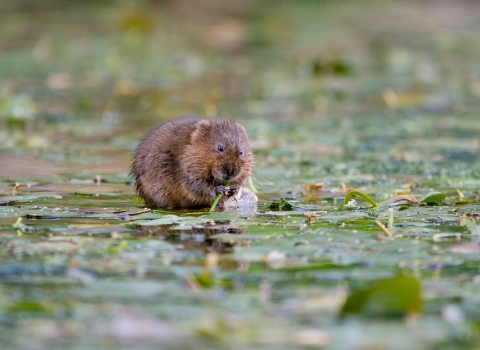
© Tom Marshall
Water Vole
Water voles were prolific in Hampshire until the arrival of American mink in the 1950s. Predation by these infamous weasels, combined with habitat loss, resulted in water voles becoming Britain's fastest declining wild mammal, and they have disappeared from many parts of the country where they were once common.
The Water Vole River Meon Reintroduction Project sought to restore some balance along our local waterways.
Led by the South Downs National Park Authority (SDNPA) and the Meon Valley Partnership, with support from the Wildlife Trust - the project saw 2,548 water voles released within the Meon Valley over a large stretch of land in which two of our nature reserves sit: St Clair’s Meadow near Soberton, and Upper Titchfield Haven near Fareham. These charismatic rodents are doing very well in their new home, and their numbers continue to rise.
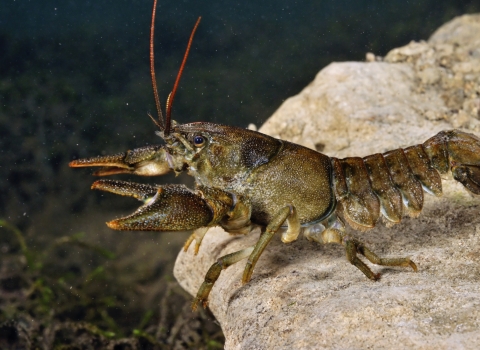
White clawed crayfish © Linda Pitkin/2020VISION
White Clawed crayfish
White-clawed crayfish is the only crayfish species native to the UK, and was once widespread throughout the majority of Hampshire’s rivers. However, this species has suffered a dramatic decline across England since the 1970’s, primarily due to the introduction of the invasive non-native signal crayfish and the resulting outbreaks of the pathogen Aphanomyces astaci, also known as ‘crayfish plague’, carried by signal crayfish and other crayfish species from North America.
The Trusts Southern Chalkstream Invertebrates project was concerned that only two populations of this species remained in Hampshire. With funding from the Environment Agency, Natural England and the Vitacress Conservation Trust, we have worked with Bristol Zoological Society to establish a captive brood stock, extended the distribution of one of the existing populations, released captive-hatched crayfish into a new site in central Hampshire, and supported the statutory bodies in protecting this species from damaging practices.
